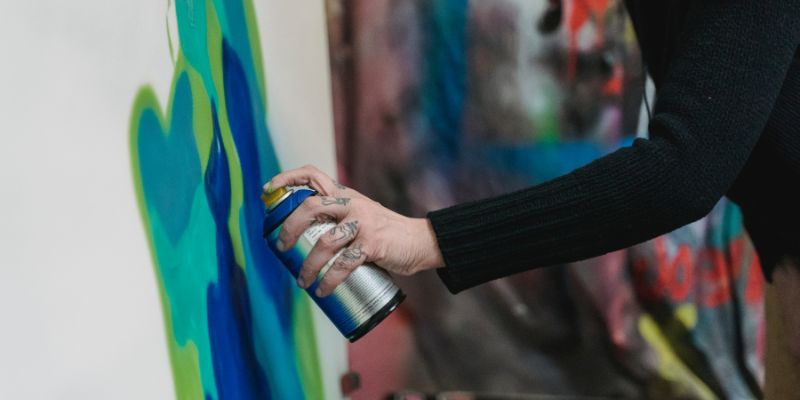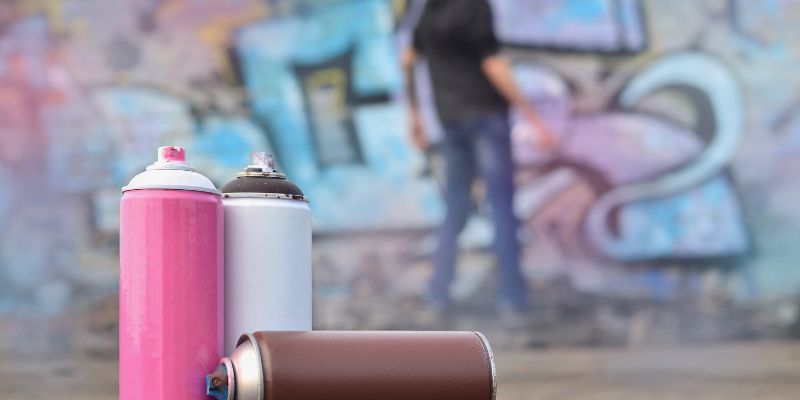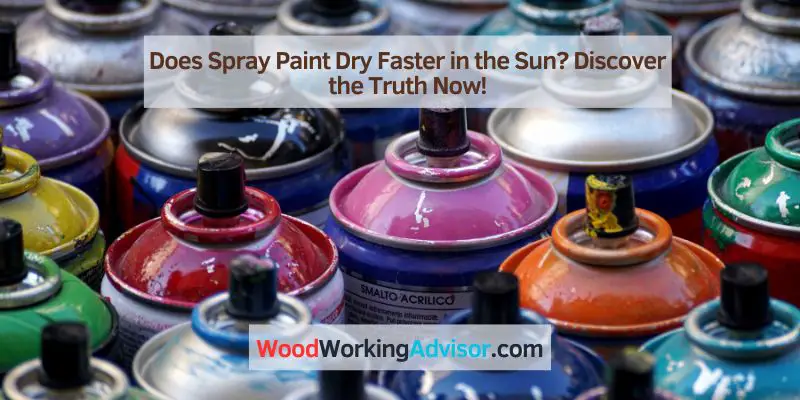Spray paint dries faster in the sun due to the heat and the increased airflow it provides. The heat helps to evaporate the solvents in the paint, while the airflow helps to speed up the drying process by moving the moisture away from the paint surface.
These combined factors result in a quicker drying time compared to when spray painting in a shaded or indoor area. However, it is important to note that extreme heat or direct sunlight may cause the paint to dry too quickly, leading to potential issues such as cracking or bubbling.
Therefore, it is always recommended to follow the manufacturer’s instructions and ensure proper ventilation when using spray paint.
Factors Affecting Spray Paint Drying Time
Spray painting drying time can be affected by various factors, including temperature, humidity, and sunlight exposure. While sunlight can help speed up the drying process, it’s important to consider other factors to ensure optimal results.
Spray paint is a popular choice for its quick-drying and smooth finish. However, the drying time can vary depending on several factors. Understanding these factors can help you achieve optimal results and ensure that your spray paint dries efficiently and effectively.

Composition Of The Spray Paint
The composition of the spray paint plays a significant role in determining its drying time. Different brands and types of spray paint contain varying levels of solvents, binders, and pigments. These components have different evaporation rates, affecting how quickly the paint dries.
- High-quality spray paints often contain faster-drying solvents, which helps expedite the drying process.
- Paints with a higher concentration of binders tend to dry faster, as binders act as a drying agent.
- Higher ratios of pigments can slow down the drying process, as they can form thicker layers that require more time to fully dry.
Understanding the composition of the spray paint you’re using allows you to select the appropriate product for your project and anticipate the drying time required.
Temperature And Humidity
When it comes to spray paint drying time, temperature and humidity are critical factors. These environmental conditions influence the rate at which the solvents in the paint evaporate.
| Temperature | Drying Time |
|---|---|
| High temperature | Faster drying |
| Low temperature | Slower drying |
- Warm temperatures accelerate the evaporation process, allowing the paint to dry more quickly.
- Cold temperatures slow down the evaporation of solvents, prolonging the drying time.
Additionally, humidity levels can affect drying time. Higher humidity can slow down the drying process as the moisture in the air hampers the evaporation of solvents.
Airflow And Sunlight Exposure
Proper airflow and sunlight exposure can also have a significant impact on spray paint drying time.
- Adequate airflow helps to dissipate the solvents in the paint, allowing them to evaporate more quickly.
- When spray painting indoors, ensure proper ventilation or use fans to promote air movement.
- Painting outdoors allows for natural airflow, which aids in faster drying.
While it may seem intuitive to think that exposing spray paint to direct sunlight would speed up the drying process, it’s not always the case.
- If the temperature is high and there is sufficient airflow, sunlight exposure can help accelerate drying time.
- However, in certain situations, extreme heat from direct sunlight can cause the paint to bubble or crack, leading to a compromised finish.
Therefore, it’s essential to consider both temperature and airflow before relying solely on sunlight exposure.
Understanding these factors affecting spray paint drying time equips you with the knowledge to achieve optimal results when using spray paint for your projects. By considering the composition of the paint, temperature and humidity, and airflow and sunlight exposure, you can ensure that your spray paint dries efficiently, resulting in a smooth and durable finish.
Effects Of Sunlight On Spray Paint Drying
When it comes to spray paint drying, one question that often arises is whether or not sunlight can help speed up the process. It’s no secret that sunlight can have significant effects on various substances, and spray paint is no exception. Understanding how sunlight interacts with spray paint during the drying process is crucial in determining the best conditions for optimal results. In this article, we will explore the effects of sunlight on spray paint drying and shed light on the science behind it.
Understanding Photopolymerization
One key factor in the drying process of spray paint is a phenomenon called photopolymerization. This term refers to the chemical reaction that occurs when certain substances, such as the binders and pigments present in spray paint, are exposed to ultraviolet (UV) light from the sun. The UV light triggers the cross-linking of the molecules in the paint, resulting in a more durable and solid film.
Photopolymerization is particularly beneficial in spray paint because it can lead to faster drying times and a smoother finish. As the sunlight interacts with the paint, the UV rays penetrate the layers, causing the molecules to bond together and create a hard surface. This process allows the paint to dry rapidly, reducing the waiting time before you can handle or move the painted object. Not only does it save time, but it also ensures better adhesion and longevity of the paint.
How Sunlight Accelerates Drying Time
The acceleration of drying time in spray paint when exposed to sunlight can be attributed to two main factors. Firstly, sunlight generates heat, which increases the temperature of the paint. The elevated temperature enhances the evaporation of solvents in the paint, promoting faster drying. Additionally, the UV rays found in sunlight initiate the aforementioned photopolymerization process, leading to the quick formation of a solid film.
The combination of heat and UV light working together in sunlight can significantly speed up the drying process, allowing you to complete your project in a shorter span of time. It’s important to note that the effectiveness of sunlight in accelerating drying time may vary depending on factors such as the paint formulation, environmental conditions, and the application technique. However, when conditions are favorable, harnessing the power of sunlight can be a valuable tool in your spray painting arsenal.
Potential Drawbacks Of Sunlight Exposure
While sunlight can undoubtedly expedite the drying process of spray paint, it’s essential to be aware of potential drawbacks associated with prolonged exposure. One noteworthy concern is the risk of paint fading or discoloration over time due to UV radiation. Sunlight contains harmful UV rays that can cause color fading, particularly in organic pigments. To mitigate this risk, it’s wise to use paint specially formulated to resist UV damage or consider applying a protective clear coat over the paint.
Additionally, extreme temperatures and humidity levels can also affect the drying process. Direct sunlight in hot weather might lead to the formation of bubbles or an uneven finish due to the rapid evaporation of solvents. Similarly, high humidity can slow down the drying time and compromise the quality of the paint job. It’s important to strike a balance between utilizing sunlight’s benefits and considering the potential challenges presented by the environment.
In conclusion, sunlight can indeed accelerate the drying time of spray paint through photopolymerization and increased heat. While it offers numerous advantages such as faster drying and improved durability, cautious consideration of potential drawbacks is necessary. By understanding the effects of sunlight on spray paint drying and being mindful of the environmental conditions, you can make informed decisions to achieve the best possible results for your spray painting projects.
Tips For Optimizing Spray Paint Drying In The Sun
If you’re a fan of DIY projects or enjoy giving your home a fresh coat of paint, you may have wondered whether or not spray paint dries faster in the sun. The answer is yes, but there are certain factors you need to consider for optimal drying. In this article, we’ll explore some useful tips for ensuring your spray paint dries quickly and evenly when exposed to the sun.
Choosing The Right Spray Paint
When it comes to spray paint, not all products are created equal. It’s essential to choose a paint that is specifically designed for outdoor use and is labeled as fast-drying. These types of spray paint usually contain a higher percentage of solvents, which helps them dry more quickly. Additionally, look for paints that offer UV protection to prevent fading or damage from the sun’s rays.
Ideal Conditions For Sun Drying
While the sun can speed up the drying process, it’s crucial to choose the right conditions for spray painting outdoors. Here are some ideal conditions to consider:
- A sunny day with minimal cloud cover: Direct sunlight is the key to accelerating the drying process, so choose a day when the sun is shining brightly. However, avoid painting in extreme heat or under direct sunlight for extended periods, as it may cause the paint to dry too quickly and result in an uneven finish.
- Moderate humidity levels: High humidity can hinder the drying process, leading to longer drying times and potential issues such as bubbling or cracking. Aim for a day with moderate humidity levels for optimal results. If the humidity is too high, consider using a dehumidifier or waiting for a drier day.
- Avoid windy conditions: While it may be tempting to take advantage of a breezy day, excessive wind can cause dust and debris to settle on the wet paint, resulting in a less smooth finish. If it’s a windy day, consider setting up a temporary windbreak or wait for calmer weather.

Preparation And Application Techniques
Proper preparation and application techniques are crucial when it comes to optimizing the drying of spray paint in the sun. Follow these tips for best results:
- Prep the surface: Ensure the surface you plan to paint is clean, dry, and free from any dirt, grease, or old paint. Use sandpaper or a wire brush to remove any loose or peeling paint before applying the new coat.
- Mask and protect: Use masking tape and plastic sheets to protect surrounding areas from overspray or accidental paint splatters. This will help you achieve a neater and professional-looking result.
- Apply in thin, even coats: Instead of applying one heavy coat, it’s better to apply multiple thin, even coats. This allows for better absorption, improved adhesion, and faster drying time. Ensure you maintain a consistent distance between the spray can and the surface while applying the paint.
- Allow for proper drying time between coats: Each coat of spray paint needs time to dry before applying the next. Check the instructions on the spray can for recommended drying times, and be patient to avoid smudging or damaging the previous layer.
- Protect from direct sunlight: While exposing the paint to the sun can aid in drying, it’s recommended to move the painted object to a shaded area once you’ve finished applying the final coat. This will allow the paint to dry evenly and avoid the risk of overheating or sun damage.
By following these tips for optimizing spray paint drying in the sun, you can achieve faster and more consistent results for your outdoor painting projects. Remember, always read and follow the instructions provided by the spray paint manufacturer for the best outcome.
Frequently Asked Questions Of Does Spray Paint Dry Faster In The Sun
Is It Good To Dry Spray Paint In The Sun?
Yes, it is good to dry spray paint in the sun. The sun’s heat helps the paint dry faster and more evenly, resulting in a smoother finish. However, make sure to choose a day with low humidity and avoid direct sunlight during peak temperature hours to prevent the paint from drying too quickly or becoming damaged.
How Do I Make Spray Paint Dry Faster?
To make spray paint dry faster, follow these tips:
1. Apply thin coats of paint.
2. Increase air circulation by using fans or opening windows.
3. Choose a warm and low-humidity environment for painting.
4. Use a hairdryer or heat gun on low setting to speed up the drying process.
5. Use quick-drying spray paint or add a drying accelerator if available.
Does Spray Paint Dry Faster In Hot Weather?
Spray paint dries faster in hot weather because the heat aids in the evaporation of solvents, accelerating the drying process. The increased temperature also helps to cure the paint, resulting in a quicker drying time.
Does Sun Affect Spray Paint?
Yes, the sun can affect spray paint. Prolonged exposure to sunlight can cause the color to fade or change, and the heat can cause the paint to crack or peel. It’s important to protect your spray paint from the sun to maintain its appearance and durability.
Conclusion
Spray paint does dry faster in the sun due to the heat and increased air circulation. This is because the sun helps to accelerate the evaporation process of the solvent in the paint. However, it’s important to note that excessive exposure to sunlight can also cause the paint to fade or deteriorate over time.
Therefore, it’s advisable to consider the weather conditions and choose the appropriate time and place for spray painting.



10 thoughts on “Does Spray Paint Dry Faster in the Sun? Discover the Truth Now!”